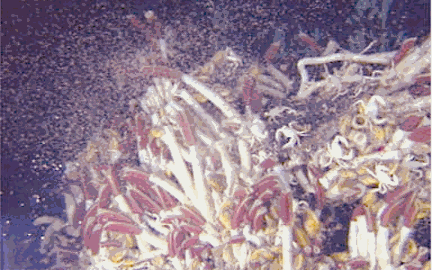
Review
http://shapeoflife.org/video/annelids-powerful-and-capable-worms
Clades: (old family) Siboglinidae or (old phylum) Pogonophora
This group includes vent species.

Not enough light penetrates beyond the upper 300 meters of the ocean's surface to support photosynthesis. Density of life falls off rapidly as organisms that live in this region depend on organic matter that drifts down from the surface.
The exceptions are highly productive communities found at 2,600 meters below the surface. These vent or deep-sea hot springs communities are found along ridges at the bottom of the ocean where the earth's crustal plates are spreading apart. Springs contain large amounts of hydrogen sulfide and hot water (350 oC).
Sulfide rich habitats harbor bacteria even in terrestrial environments that get energy for carbon fixation from the oxidation of hydrogen sulfide. But vent communities are unusual in that these communities harbor so many multicellular eukaryotic organisms.
The answer to this paradox lies in a number of adaptations most of which depend on establishing symbiotic relationships with bacteria that can fix carbon dioxide using hydrogen sulfide.
Riftia pachyptila an example. Large worm harbors bacteria in muscle. Has special type of hemoglobin (the protein connection) for transporting sulfide to bacteria.
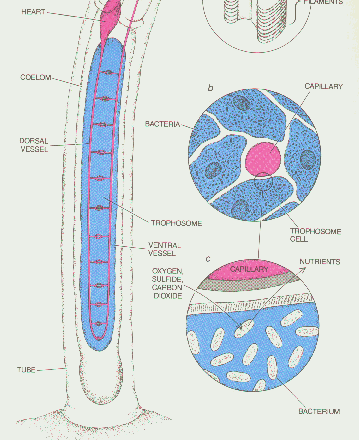
The fossil record of pogonophorans may extend back to the Vendian Period; long thin tubes known as sabelliditids have been found in rocks of that age, and somewhat resemble pogonophoran tubes.
Another unusual benthic marine habitat with worms as key players.
Echiura: Old Class or phylum
The body of an echiuran lacks annelid-type segmentation, but the distinctive free-swimming trochophore larval stages of echiurans and polychaetes are very similar. Nervous system and circulatory system when present is much like that of annelids. There are structures lined with ciliated cells that connect to the rectum and probably serve as excretory organs.
Echiurans have an extensible proboscis or introvert and most have a set of small hooks at the end of the proboscis; hence the Latin name of the phylum, "spine-tails." In English, echiurans are referred to as spoon worms.
http://www.flickriver.com/photos/tags/echiura/interesting/

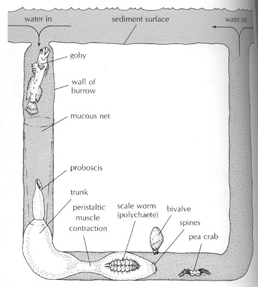
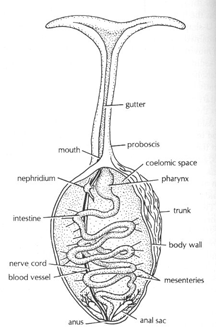
In the species Bonellia viridis, females are typically 8 centimetres in body length, but the males are only 1 to 3 millimetres long, and spend their lives within the uterus of the female.
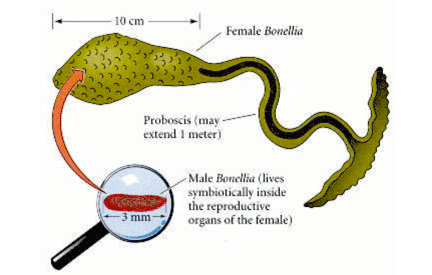
Most books now put these is a separate phylum. Your book considers this a class of Annelids.
U-shaped burrows are known in the fossil record from Cambrian times. Some of these trace fossils may have been made by echiurans, but a number of other organisms make very similar burrows. Body fossils of echiurans are much rarer, since echiurans have no hard parts. The oldest plausible echiuran fossil is Pennsylvanian.
They are a popular food item in some countries.
Clade or old Phylum Sipuncula or Spunculida
These animals, which are commonly called "peanut worms" because some have the general shape of shelled peanuts, are not particularly well studied. Only about 320 species have been formally described, all marine and mostly from shallow waters. They burrow into sand and mud, or live in crevices in rocks, or in empty shells.

The body is completely unsegmented, and the intestine forms a twisted loop, with the anus on the side of the body. Typical of sipunculans or sipunculids is an anterior body section, the introvert, which can be retracted into the body by the retractor muscles. At the tip of the introvert is the mouth, which is surrounded by a ring of tentacles. Sipunculids have no circulatory or respiratory systems; the coelomic fluid transports both nutrients and oxygen to all parts of the body. Nephridia filter the coelomic fluid. The body cavity of sipunculans is large and filled with fluid, in which are found free-floating cells known as hemerythrocytes (circulation) as well as free-floating clusters of cells known as ciliary urns ( excretion, although sipunculids have metanephridia)

Sipunculids have an extremely sparse fossil record -- with one possible exception. A group of fossils known as hyoliths is found in rocks through much of the Paleozoic, 543 to 248 million years ago, that includes the Cambrian. a few fossil hyoliths have been found that show traces of the intestine and the hyolith intestine is looped and coiled, much like that of living sipunculids. A few living sipunculids secrete a calcified cuticular plate, the anal shield, so it is not impossible that past relatives of the sipunculids secreted more extensive shells.
Sipunculids are sometimes thought to be a group of annelids, and have been classified within them. However, this phylogenetic hypothesis is contradicted by comparing the anatomy of annelids, sipunculids, and other animals. For instance, sipunculids have no trace of important annelid characters such as segmentation and setae. The characters they do share with annelids (e.g. worm shape, introvert, trochophore larva) are not restricted to annelids and sipunculids.